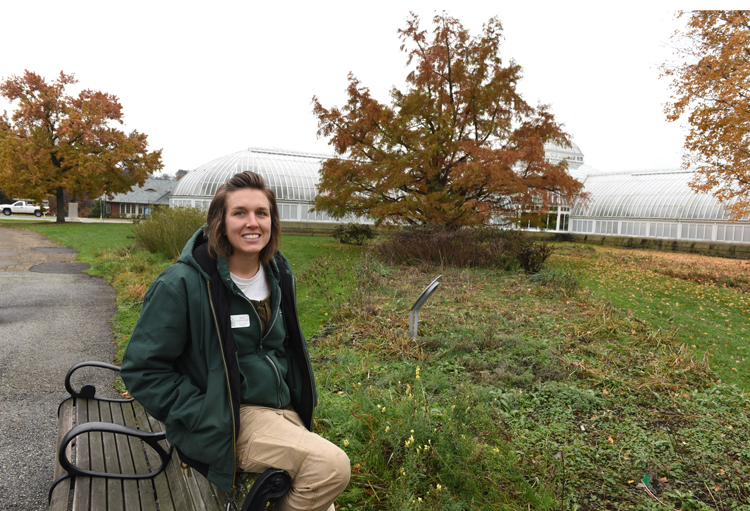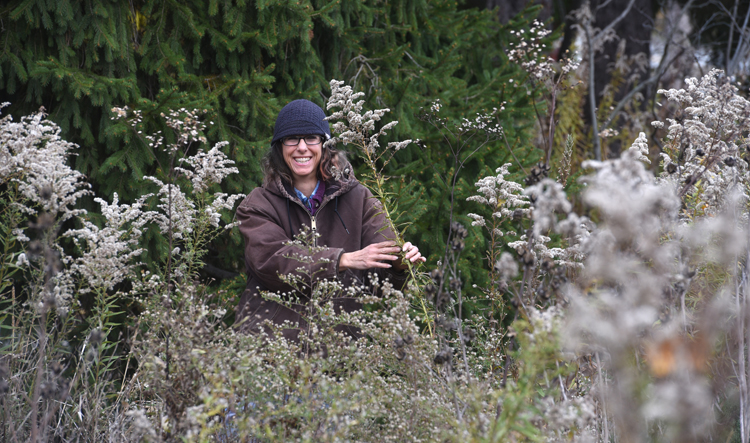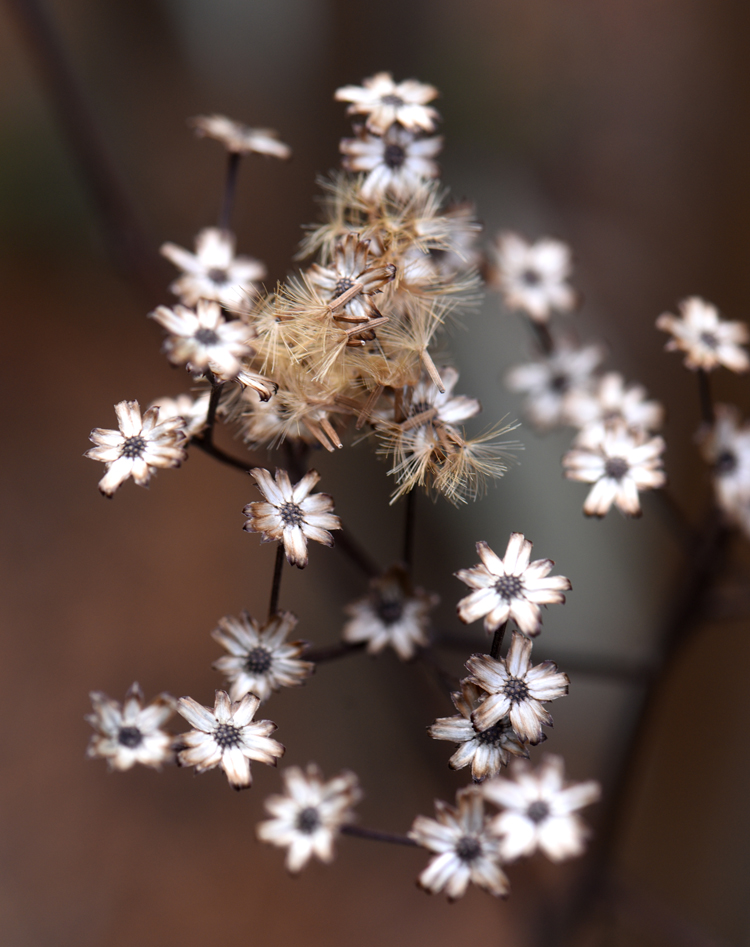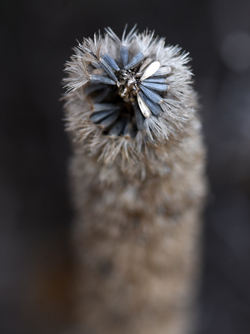Putting the garden to bed
Posted on: November 16, 2017 | Written By: Doug Oster |
Even though they are only about 6 years old, Jessica Horenstein’s work boots are already starting to reveal the silvery steel toes wearing through the leather, caused by the long hours she spends on her knees working in the garden.

Jessica Hornenestein is an outdoor display foreman at Phipps Conservatory and Botanical Gardens. Some of the beds she tends have annuals with are removed, but many perennials are left up for the winter. Photos by Doug Oster
Horenstein has readied the beds at Phipps Conservatory and Botanical Gardens, where she’s outdoor display foreman, for winter, and she has lots to great tips for gardeners to close their gardens for the season.
The gardens in front of the Welcome Center were filled with annual flowers all summer and now the area in transition.
“This is the time of the year when we’re digging them out, getting the roots, all the debris and then planting over 5,000 tulip bulbs,” she says.
Even though that’s too many for the home gardener, tucking a few bulbs in the ground before it freezes is always a good idea, she adds.
“We do sprinkle a little Repels All in,” Horenstein says, “because we have a lot of critters, it just keeps them away.”
General tips • If plants are diseased, they should not be put into the compost pile as they might compound the problem next season.
• “You may want to put back a little bit of compost or mulch (in the beds) to protect from that freezing and thawing cycle. In Western Pennsylvania anymore we can’t count on a blanket of snow which obviously does help insulate,” Horenstein says. She recommends 2 to 4 inches of mulch, which also keeps precious garden soil in place over the winter.
• It’s easy to create a good edge between lawn and garden this time of year as the soil is soft, Horenstein says.
Plan for next year There are other end of the season tasks, she says, but everyone looks at the end of the season differently. “Some gardeners have more steam at the end of the season and then some people have more energy in spring,” Horenstein says.
When things are cleaned up, Horenstein recommends spending time in the garden planning for the next season. “All winter stare at your trees, see what branches are bugging you,” she says with a laugh. “It’s a time to look at the bones of the garden.”
This self-described “plant nerd” loves to observe, record and study what’s growing in all the gardens she is responsible for. “For me this is all about a big fun science experiment and it’s the anticipation of what’s going to happen next.”
That’s one of the reasons the native plants growing around the Center for Sustainable Landscapes are left up for the winter.
“In the CSL we don’t cut anything back,” she says. “We talked about protecting perennials with compost or mulch, but if you leave the stalks they collect leaves and then get a snow mound, you’re basically doing the same thing, so why not let nature do it.”
Soil tests Fall is one of the best times for a soil test too, Horenstein says. “Then you can add amendments in the fall that can work all winter long.”
The Penn State Cooperative Extension offers soil tests for under $10 which provide valuable information to improve the garden. Since most gardeners test in the spring, the lab won’t be busy now and will send results back quicker.
“Never add anything to your garden without a soil test,” she says. “We want to do what’s best for the plants and you really can’t do that without the science.”
On thing that’s critical is having the right pH for the right plant and that’s where the test gives gardeners a scientific number to work with and an exact formula to get the pH right. Regardless of the soil fertility, if the pH is not ideal, the plant can’t thrive.
Hands off approach

Roxanne Swan is coordinator of the Audubon Center for Native Plants at Beechwood Farms and an environmental botanist. At the end of the season she leaves most of the native perennial plants in place to benefit wildlife.

Common milkweed seeds are of interest to some insects which will also attract birds.
Roxanne Swan, coordinator of the Audubon Center for Native Plants at Beechwood Farms in Fox Chapel, is turning over the soil in long trial beds. The environmental botanist leaves most of the perennial native plants around the nursery uncut at the end of the season.
“In the fall we’re all about bird food,” she says. “We look at these plants as the last food source for birds, wildlife and a place for pollinating insects to nest and get ready for the spring.”
Things like spicebush, Virginia creeper, liatris, sunflowers, hibiscus, coreopsis, goldenrod, coneflower and others have seeds that birds will feast on. The Virginia creeper is often referred to as a weed and mistaken for poison ivy. It’s a fast growing vine that produces berries for the birds and the leaves turn deep red at the end of the season, putting on a show for the gardener.
“I think if you see the fall color, you’re sold,” Swan says. There are even cultivated varieties of the plant on the market now.
Some plants going to seed, like milkweed, attract insects that in turn also bring the birds which feed on the bugs. Many gardeners have been taught to basically clear cut the perennial garden and that’s how they like the landscape to look over the winter.
“That’s an aesthetic that everybody has a different view of,” Swan says.
She sees more people though going beyond the look and helping the environment by leaving these plants alone for the season.
“You’re having some texture in the garden too,” she says. “Sometimes just the stem architecture is lovely.”
That certainly includes ornamental grasses and they are great habitat and food for wildlife.
Swan also encourages gardeners to leave things like Joe pye weed, milkweed, hydrangea and anything else with a hollow stem alone, they are a great place for native bees to spend the winter.
“We have mason bees and leaf cutter bees that are looking for a place to nest,” she says. “Our native bees are under a lot of stress.”
Hollow stem nesting plants can be removed as the new growth appears in spring. If it’s driving you crazy at the start of the season, the stems can be cut and bundled with string and put somewhere warm where the good bugs can hatch out. On top of a compost pile is the perfect place.

Vernonia noveboracensis (New York Ironweed) produces seeds for the birds.
Swan says that if a plant going to seed outside the front window is unsightly, cut it and put the seed heads somewhere the birds can get them. It’s never ugly to her though, she sees something in them that others might not if looking out that same window.
“I would enjoy the texture, beauty and life it’s giving in the middle of winter, what’s better than that, it’s amazing,” she says.
Doug Oster is editor of Everybody Gardens, a website operated by 535Media, LLC. Reach him at 412-965-3278 or doster@535mediallc.com. See other stories, videos, blogs, tips and more at everybodygardens.com.

Liatris spicata (Blazing Star) produce lots of seeds for the birds.
10 great native plants
Roxanne Swan, coordinator of the Audubon Center for Native Plants at Beechwood Farms in Fox Chapel, was asked to recommend 10 native plants and name them as fast as she could. Swan was just getting started.
• Amelanchier arborea, Serviceberry
• Lindera benzoin, Spicebush
• Rudbeckia triloba, Three-lobed Coneflower
• Coreopsis tripteris, Tall Tickseed
• Impatiens capensis,Jewelweed
• Solidago rugosa, Rough-stemmed Goldenrod
• Asters including Symphyotrichum oblongifolium, Aromatic Aster
• Asclepias syriaca, Common Milkweed
• Asclepias incarnata, Swamp milkweed.
• Cornus amomum, Silky Dogwood